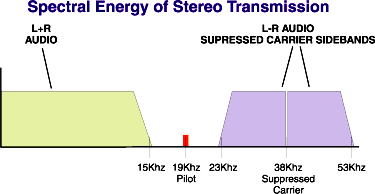Technical Note BC-01
Pre-emphasis, Low-Pass Filtering & Why
It's So Important
BACKGROUND:
Pre-emphasis is related to maximum frequency by the modulation
index, which for FM broadcast in this country, is arbitrarily set
at 5 by FCC regulations.
Pre-emphasis is required because noise interference may produce
indirect FM by shifting the phase of the carrier; high audio
frequency noise produces more equivalent FM than does lower
frequency noise. Because signals in the higher-end of the audio
spectrum usually have less energy than lower frequency signals,
the uncompensated transmitter has rather poor signal-to-noise at
the higher frequencies. Pre-emphasis was introduced to correct
this condition by exaggerating the high frequency response during
transmission and attenuating it by the same amount during
reception. Another way to look at the reason for preemphasis and
an upper limit on audio response is by working out the formula
for modulation index, or deviation ratio:
Max Deviation
------------------ = modulation index
Highest audio freq
Since the index is arbitrarily limited to 5, we can see how
the upper limit of 15khz is derived:
75,000hz
------------ = 5
15,000 hz
The need for an input filter is always present, although much
more important than ever when broadcasting a stereo signal.
Program material rich in harmonic overtones can easily exceed
15khz and heterodyne with the 19khz pilot tone. Worse than that,
it can heterodyne with the lower sideband of the L-R subcarrier
modulation, which moves closer to overlapping as signal frequency
increases. For this reason, a SHARP cutoff audio filter is
required after 15khz. How steep is the rolloff? Well, imagine a
"brickwall" filter that begins to roll off and is down
3 db at 15.5khz and then is down more than 40 decibels at 19khz.
An 8-pole filter, supplemented by a resonant band reject circuit
is suited for this. If such a filter were omitted, frequencies
could risk being high enough to overlap. Since the subcarrier
spectra is both the sum and the difference of the audio frequency
against the 38Khz subcarrier, the higher the modulating
frequency, the lower the bottom or left sideband on the chart
below would extend, and the higher the upper sideband would
extend. Eventually, as the frequency goes high enough, the actual
program tone and the lower sideband would overlap with the pilot
tone and eachother. The upper sideband may interfere with SCA
(Subsidiary Communications Authority) services at 67Khz and
higher.

Removal of audio program frequencies above 15Khz. is also
important in mono transmissions because of carrier sideband
generation. The carrier frequency plus the sum and the difference
of the audio frequency that is modulating it represents the
first-order sidebands. From that point outward, exist additional
orders, each spaced further out by the same interval of the
modulating frequency, but at diminishing amplitudes. The higher
the modulation frequency, the wider the spacing of intervals. And
when modulation index of 5 is reached, the order of sidebands
rises to 8 on either side of the carrier. If there were no upper
limit on audio frequencies allowed to modulate the transmitter,
these sidebands would extend into adjacent channels, causing
interference.
Please make every effort to be a responsible broadcaster.
The more knowledge you have, the better your capabilities to
reach this standard and very important goal.
Authored by your friendly "Peg-legged" Bovine One
